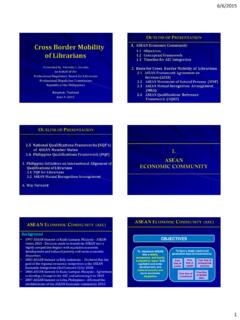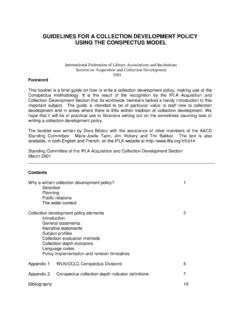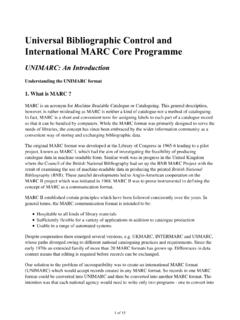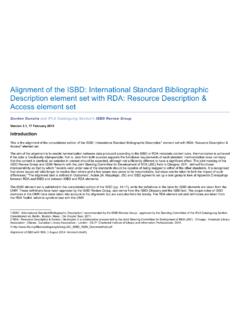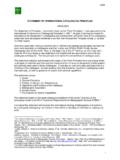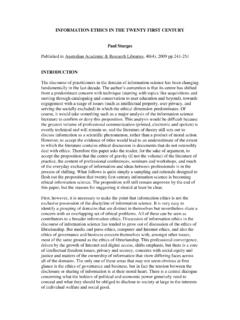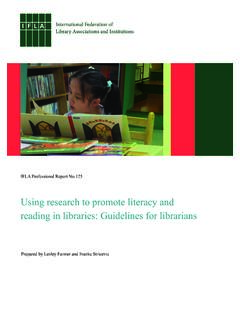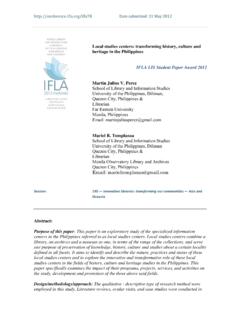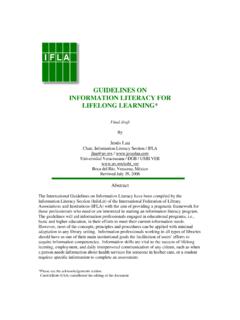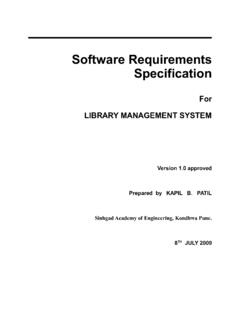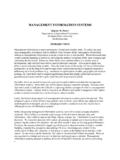Transcription of Designing and Building Integrated Digital Library Systems ...
1 International Federation of Library Associations and InstitutionsIFLA Professional Reports, No. 9090 Designing and Building IntegratedDigital Library Systems -GuidelinesBy Bente Dahl Rathje, Margaret McGrory, Carol Pollitt, PaiviVoutilainen under the auspices of the IFLA Libraries for the BlindSection. Copyright 2005 International Federation of Library Associations and InstitutionsAcknowledgementsThis publication, commissioned by IFLA Libraries for the Blind Section, was prepared by:Bente Dahl Rathje, The Danish National Library for the Blind, DenmarkMargaret McGrory, The Canadian National Institute for the Blind Library , CanadaCarol Pollitt, National Library for the Blind, United KingdomPaivi Voutilainen, Celia Library for the Visually Impaired, FinlandWith contributions provided by.
2 Helen Brazier, National Library for the Blind, United KingdomThomas Christensen, The Danish National Library for the Blind, DenmarkBarbara Freeze,The Canadian National Institute for the Blind Library , CanadaRebecca Herrington,National Information and Library Service (NILS), AustraliaBirgitta Irvall, Swedish Library of Talking Books and BrailleRosemary Kavanagh, The Canadian National Institute for the Blind Library , CanadaKatariina Kiiliainen, Celia Library for the Visually Impaired, FinlandVictoria Owen, The Canadian National Institute for the Blind Library , CanadaEric Sharf, The Canadian National Institute for the Blind Library , CanadaDesigning and Building Integrated Digital Library Systems Guidelines / By Bente DahlRathje, Margaret McGrory, Carol Pollitt, Paivi Voutilainen under the auspices of the IFLAL ibraries for the Blind SectionThe Hague, IFLA Headquarters, 2005.
3 67p. 30 cm. (IFLA Professional Reports : 90)ISBN 9077897054 ISSN 0168-1931 Version II 4 October 2004 Table of Purpose of these Would Benefit from these 52 What is an Integrated Digital Library system ?.. of the components of an an IDLS for users who are to address prior to Designing an 63 Planning an IDLS the Scope of an IDLS Envisioning Initial Planning to versus the Business Case for an Process Reengineering (BPR).. and Financial 104 Content Building for Digital of Digital of Digital Digital and Storage media for accessible Digital to other Digital on-site Hard Copy Collections and Online Collection and Related Legal Copyright in the Digital and Potential of International Digital Content between Libraries for the 155 Archiving, Storage and Managing Digital Handling Digital the Production and Preservation of Digital Assets.
4 And DigitalRights Held for these 176 The E-Delivery in the Digital the User in the Digital Users and Staff to Access Content in the Digital Issues and Delivery of both Physical and Electronic and the 20 Version III 4 October Model versus Demand in the Security and anti-virus and up 237 Developing the IDLS Project the IDLS Project of a Requirements Marketplace for Partnerships with other with Vendors and system the Project the Project Milestones and Sign-Off Human Resources and Appropriate on Go live versus Big Bang the Implementation Testing and and Support and Help other Achievement of Project if Project Goals are Achievement of 1 Training and Support 2 The User 3 Case 4 Glossary of 5 - Typical User Profiles (NILS).
5 47 Version IntroductionLibraries have always been a community s portal to information, knowledge and their shelves, libraries are a community s gateway to information from manysources nationally and internationally. Libraries provide professionals trained todistinguish and verify content, build collections and provide a reference and informationservice. Today more libraries rely on electronic sources for collecting, organizing anddistributing information age has created unprecedented opportunities to acquire electroniccontent from many sources including existing Digital content in many different types oflibraries. The concept of a world Library for the blind rests on the ability of digitallibraries to share and coordinate collection- Building resources and to use digitaltechnology to share content.
6 It requires Designing these Systems and services withinteroperability in mind and using common standards. It begins with a sharedunderstanding that technology does not fundamentally change Library service, but ratherthe way in which it is organized and delivered. Therefore, guidelines for the developmentof the Digital Library must begin with the assumption that the Library remains a collection oforganized content reflecting works of imagination and information necessary to facilitatelife long learning, career development and an informed citizenry. Its digitization is a meansof ensuring that its collections are preserved and accessible to all regardless of work has been done through the Digital Accessible Information system (DAISY)Consortium and with NISO to establish standards for the recording of navigable digitalaudio books.
7 For many libraries for the blind, the focus of the past five years has been onthe implementation of these standards and the conversion of their analogue collections todigital audio. Others are Building collection resources through the Internet and accessingremote sources for the content they distribute to their users. The Internet is both a sourceof content and a means for distribution. It has profoundly changed information servicesfor users and libraries. Publishers of content, trade books and magazines, electronicjournals and electronic databases offer new opportunities for acquiring, managing anddistributing content that is increasing complexity of the environment, the many sources of information, thevariety of electronic and other formats such as Digital audio books and materials, brailleand large print, which must be managed and Integrated into a seamless service haveforced libraries for the blind to seek more sophisticated technological solutions designedfor their community of users.
8 Consequently, in Designing and Building of Integrated digitallibrary Systems , the front-end, or user-facing services, must be considered along withthe back-end supporting technologies, Systems , and underlying The Purpose of these GuidelinesThe purpose is to provide libraries for the blind and those who work in them with a broadoverview of matters to be considered in planning and implementing an Integrated digitallibrary guidelines are not intended to provide technical solutions. Given the pace oftechnological change, solutions can only be developed with intensive review ofmarketplace developments specific to each Who Would Benefit from these GuidelinesLibraries and other organizations providing a service to populations experiencing visionloss, those who because of a disability cannot read conventional print or experience aperceptual difficulty in comprehending print.
9 These libraries may include public libraries,national libraries or other libraries serving those who are print disabled. However, it isworth noting that apart from content dealing with accessibility and copyright and relatedlegal matters which are particularly relevant to libraries serving print-disabledpopulations, the Guidelines can be used by any Library seeking information about what toconsider when implementing an Integrated Digital Library What is an Integrated Digital Library system ?The term Integrated Digital Library system (IDLS) means different things to differentpeople. Examples of what constitutes an IDLS vary from one organization to another ( Appendix 3 Case Studies). Definition of the components of an IDLSThe components that comprise an IDLS may include the following functions:Acquisition: The collecting of Library assets and material through purchase, exchange, orlicense.
10 As part of this function, the system should facilitate the acquisition orpermissioning of the Digital rights of an asset, as well as the enforcing of those rights withregard to the use of the and indexing: The proper and consistent description of assets which enablesusers to search for and retrieve those assets using cataloguing standards such as MARC format and Dublin Core of Digital books and other content: The management , naming conventions, andtracking of Digital assets, and the ability to retrieve them easily for production or include: The management of the creation (production) of Digital assets -- the tasks orworkflows, production resources, human resources, and the management of them,and the Digital works-in-progress.
